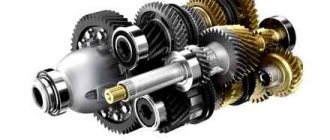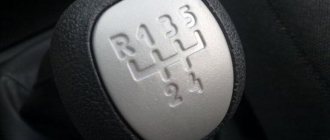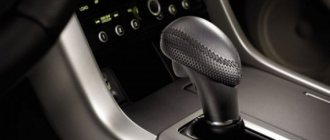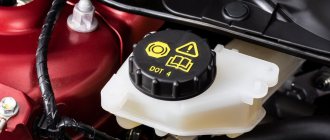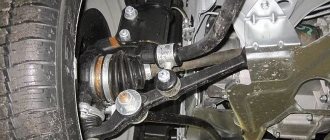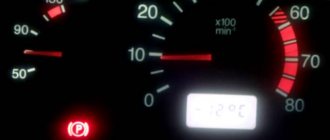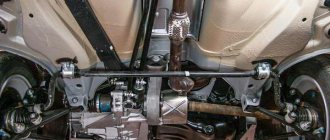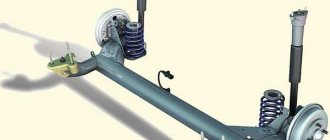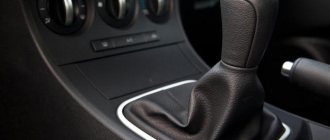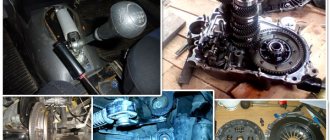01/26/2022 26,550 checkpoints
Author: Ivan Baranov
The gearbox is a rather complex unit that requires proper attention and diagnostics. Today, the problem of poor gear engagement is relevant for many vehicles, so it is important to understand how the unit is diagnosed and repaired. From this material you will learn why first gear is difficult to engage, what is the reason for this, and how you can engage first gear if necessary.
[Hide]
For what reasons do interruptions occur?
The gearbox is not only one of the most complex, but also one of the most basic components in any vehicle. The reasons for malfunctions that make it difficult to engage first gear can be associated with both incorrect use of the unit and driving on a bad road surface. In any case, if you don’t know why the speed turns on poorly, then this indicates a certain breakdown of the unit itself.
Gear lever
It should be noted that a similar problem often occurs in older cars that are bought second-hand and not at car dealerships. Therefore, if you purchased a used car, then you shouldn’t even be surprised by such a problem, especially since similar faults will appear in any car sooner or later. In addition, if you try to turn on the speed and this happens, but very poorly and with great difficulty, then over time the unit selector may completely stop responding to any commands from the motorist. Naturally, not every driver will be able to constantly start driving in second gear, so it is important to understand the reasons why first gear is difficult to engage.
Below is a list of breakdowns that can cause the gear lever to shift gears poorly:
- The problem is in the clutch operation - the mechanism engages poorly, disengagement is incomplete. This problem often occurs in domestically produced cars and in most cases it is due to the fact that the mechanical clutch cable comes off from the mounting point. In fact, it is not particularly difficult to identify this - if the cable breaks, the pedal will be recessed into the floor and will not move. This, as you understand, is directly related to the operation of the clutch, and not the gearbox.
- There was a breakdown in the operation of the drive rod for controlling the gear shift mechanism. Then not only the first, but also the reverse and other speeds will turn on poorly.
- Failure of the unit's jet thrust.
- For unknown reasons, the fastening bolts located on the side or selector rod for selecting the gearbox mode have become loose. The problem is solved by tightening the bolts.
- The transmission gear shift drive was incorrectly adjusted.
- The plastic elements in the gearbox control drive have failed or have expired.
- The link was poorly adjusted. As you know, the purpose of the rocker is very important in connecting the gearbox and the gear selector, so incorrect adjustment may well be the cause of the problem. In addition, the plastic bushings on this link could wear out or fail.
- Failure of synchronizers can also be called one of the most common failures in a gearbox. Unit synchronizers are brass bushings necessary for easier switching of unit modes. Since brass itself is a soft material, it can wear out and wear out during the operation of the vehicle. To correctly diagnose the condition of the synchronizers, you should pay attention to the operation of the gearbox - if a grinding or unpleasant sound appears when shifting gears, then the problem is in them. Moreover, this sound will appear constantly when you try to engage first gear. If only sound appears, but the gearbox selector switches to one mode or another without problems, then a malfunction will occur soon.
- Failure of gearbox bearings. Such a malfunction does not occur so often, one might even say that it is rare, but any motorist can still encounter it. If you own a car with a manual transmission, then the bearings could get stuck in it, as a result of which the shaft stops rotating along the path. In such cases, it is difficult to engage first gear; at other speeds the problem usually does not appear.
- The box shaft has failed. The unit shaft is usually not subject to operational wear or very heavy loads, but the malfunction may be caused by a factory defect. In the event that even minor mistakes were made in production, the shaft may well break. If so, then the problem of engaging the first gear may be just the beginning of a major breakdown that you will face. As practice shows, often in such cases the unit itself breaks down completely.
- The problem of clutch failure is relevant for owners of cars with automatic transmission. There are cases when, if the clutches are not functioning correctly, a push occurs when the first speed is turned on, but then everything works fine. The problem can only be solved by replacing the clutches.
Failed bearing
You, as a motorist, need to understand that failure of the unit shaft or bearings cannot be diagnosed at home. Only experience and equipment will help you understand this reason. Accordingly, if problems arise with turning on the first speed, it is advisable to immediately contact a professional.
If you have a mechanic
Gears shift poorly in a car with a manual transmission for three reasons. The first of these is a malfunction of the clutch when it does not completely disengage (drive). The first sign of this malfunction is that the reverse gear is engaged with a characteristic crash. The rear one reacts to this anomaly more noticeably than other gears, because it is the only one not equipped with a synchronizer.
The second reason is a defect in the gear selection mechanism of the gearbox. And finally, the third is excessive wear of the gearbox synchronizers.
There are also several clutch malfunctions in which manual transmission gears shift poorly:
- Air in the clutch release hydraulic drive or fluid leakage from it. The malfunction is eliminated by replacing failed components of the hydraulic system and pumping it.
- Worn or broken clutch release fork. The part requires replacement or repair.
- Warping (runout greater than 0.5 mm) or too thick new driven disk.
- Failure of the basket (temperature deformation of the pressure plate or its distortion).
- Loss of mobility of the support bearing of the gearbox input shaft (at the end of the crankshaft to which the flywheel is attached).
- Jamming of the clutch driven disc hub on the splines of the gearbox input shaft. To eliminate the defect, clean the splines of the gearbox hub and input shaft. It wouldn’t hurt to lubricate them a little with lithol.
There is too much free play in the clutch release fork. Its value needs to be clarified with the manufacturer, since it is slightly different for different cars. Until you find out the value of this parameter for your car, set it from 5 to 8 mm. Too little free play of the fork is also undesirable, as it leads to clutch slipping and increased wear of the release bearing.
Excessive wear of synchronizers mainly occurs in those gears that are engaged more often: these are usually first, second and third. The rear one is not included in this list because it does not have a synchronizer. When your gear shifts poorly, and you assume that the reason for this is wear of the synchronizers, firstly, you should only have difficulties with this while driving. Secondly, in this case it switches better if you use double squeeze.
For those who don’t know what double squeeze is. To shift to a higher gear: depress the clutch, engage neutral, release and depress the clutch again, engage the gear.
Backlash in the so-called “helicopter” is one of the reasons for unclear gear shifting
To switch to a lower gear: double squeezing must be combined with re-engaging, that is, when the clutch pedal is released and the gearbox is in neutral, you need to press and release the accelerator pedal. This is how gears are changed in cars that do not have synchronizers. If the gearbox shifts easier using double squeezing, then the culprit for poor gear shifting is most likely worn synchronizers.
If the gears shift poorly when the car is standing still with the engine turned off, the fault may only be in the gear selection mechanism of the gearbox.
Look for damage or check that it is adjusted correctly. Don't even think about the clutch and synchronizers.
How to engage first gear without harming the gearbox?
Often, inexperienced motorists, turning the gearbox selector from second to first speed, may notice how some difficulties arise, in particular, how difficult it is to engage first gear. In such cases, a novice driver often tries to turn on the speed using force, simply by driving the selector into the desired position. This should not be done under any circumstances, since such actions can be fraught.
Actually, having noticed such a drawback in the manual transmission, motorists developed a rule - the first speed should be engaged only in order to move away. In all other cases, second, third and fourth gears are engaged. Experienced motorists especially often use this rule, but we would like to say on our own that this is fundamentally wrong.
Operating principle of gearbox synchronizers
Any driving instructor will tell you that the choice of speed should be based on driving speed and engine crankshaft speed. In principle, even parking normally is only possible in first speed. If you try to park in second gear, you will have to maneuver very quickly, and in such cases there will be a strong load on the clutch. Actually, just like the gearbox unit itself. Accordingly, you must learn one simple rule for yourself - you can engage first gear when driving only if the speed is low and the crankshaft speed is low.
Problems with automatic shifting
An automatic transmission is very demanding in maintaining the oil level and its condition, unlike a manual transmission.
Too high or low oil level can lead to machine malfunction. In addition, due to a lack or excess of oil, difficulties may arise in switching gears. The most common automatic transmission faults:
- Forward gears do not engage.
- There is no reverse gear, forward there is only 1st and 2nd.
- All speeds are engaged except reverse.
- The gears don't engage at all.
The oil level in the automatic transmission is checked using a dipstick. If the oil level is low, add.
Theory of gearbox operation
Every motorist who understands the structure of a gearbox knows that all modern cars with a manual transmission are equipped with synchronizers. This element is one of the important components of the unit. The purpose of synchronizers is to equalize the speed of all gearbox shafts. In addition, these elements are responsible for painless and shock-free gear shifting for the box.
It should be noted that directly when the driver pushes the gearbox selector when switching from second to first gear, you can feel an obstacle. This obstacle prevents the activation of the first speed and it is this obstacle that is called the synchronizer. If the gearbox is relatively new or a synchronizer has recently been installed on it, then you will not experience problems with the transition from high speed to low speed. The first gear will be engaged without any obstacles.
Worn out synchronizer
But if your vehicle has already traveled more than a hundred thousand kilometers, then this will directly affect the functioning of some elements of the unit. In particular, first of all, synchronizers will stop working normally - they simply will not be able to perform the tasks assigned to them initially. Then the motorist is forced to perform various “tricks” that our grandfathers told us about - these are all kinds of gas shifts with double disengagement of the clutch and so on.
When performing such tricks, the throttle change will act as an equalizer for the interconnected gears. Thus, if the difference in angular speeds is high, and the synchronizers are worn out quite badly, then the driver will have to accelerate even more. In the case when the angular speeds are the same, the motorist will immediately understand this - the gearbox selector will be able to switch from high speed to low speed without any problems. Thus, it will no longer be worthwhile to make efforts.
New synchronizer for gearbox
Advice for motorists
Above we have already talked about why the reverse gear on the VAZ 2114 does not engage and how to correct this situation. But it should also be noted that proper and timely care of the gearbox will help either completely avoid such a situation or postpone it for as long as possible.
There are only two basic rules for this care:
- Change gears, as well as accelerate and brake the vehicle as smoothly as possible, without jerking.
- Periodically check the oil level, replenish it as it is used, and also replace the entire volume if it is worn out.
These simple rules will help to significantly increase the service life of the entire box and its individual parts.
Methods for engaging first gear
So, if the modes in your vehicle are difficult to engage and you have already understood the reasons and theory, then let’s move on to the most important thing - methods for engaging first gear. The simplest method in this case would be to activate first gear while driving the car. You need to push the unit selector forward without any effort and do this until the corresponding synchronizer comes into operation. However, it should be noted that this method is relevant for most passenger vehicles and some trucks.
It should be taken into account that this cannot be done in most old trucks, since the design of the unit itself does not allow this, since they simply do not have synchronizers. In addition, you need to take into account that this method of activating the first speed is hardly relevant if the synchronizer on your vehicle has already exhausted its service life. This will simply be impossible.
Double car re-gas
Then the driver will only have to wait a while until the car practically stops in order to turn on the desired speed. Or use force to engage the gearshift lever. In principle, neither the first nor the second method can be called the optimal solution to such a problem. As practice shows, it is best to use the same old-fashioned method with re-gasping.
You can find out how to do this below:
- So, while driving in second gear, start depressing the clutch pedal.
- When you press the pedal, move the gearbox selector to the neutral position. Having done this, you can disable the clutch pedal.
- Then, when the pedal is completely lowered, you need to lightly press the gas with your right foot, pressing the pedal. In this case, pay attention to the tachometer, which shows the number of revolutions. You need to increase the revolutions to two and a half thousand per minute, that is, the needle should be at the number 2,500. Here, pay attention to one important nuance - the greater the difference in angular speeds of the mating gears of the box, the higher the number of revolutions needs to be raised. That is, 2,500 is the minimum, add gas if necessary.
- Then depress the clutch pedal again.
- Next, the box selector should be moved to the initial mode activation position, that is, first speed. Here, also pay attention to the fact that if the selector does not enter the required position correctly, then most likely you simply did not give enough gas. If this is the case, then repeat the steps, only add more gas.
- As a result, you need to release the clutch pedal smoothly, not abruptly. If you did everything correctly, the gearbox lever will move to the required position without any problems, shocks or extraneous sounds.
If you were unable to do this, then do not be discouraged - rarely does anyone manage to perform a double gas change the first time. By repeating the procedure several times, you will be able to remember everything that needs to be done to correctly engage the first speed. Actually, the same methods allow you to activate first gear when driving in third, for example, if in an emergency you need to brake the engine. In this case, the higher the driving speed, the longer you will need to wait for the synchronizers to help you. Or you need to press on the gas more.
But do not regard double throttling as a way out of the situation. This method can be called a temporary solution, but the unit will still have to be repaired. Since replacing synchronizers is a rather complex process, we recommend that you seek help from specialists. If you still decide to perform this procedure yourself, then the instructions provided below will be useful to you.
Loading …
Changing synchronizers
Replacing gearbox elements is carried out in several stages. We will not describe them in detail, since all actions are individual for each individual car.
Moreover, if you have never encountered such a procedure, you are unlikely to be able to perform it yourself:
- First you need to remove the gearbox from its installation location. To do this, use the recommendations in the service manual or search our resource - here you can find several instructions. The dismantled gearbox is thoroughly cleaned of dirt and dust.
- After this, you should remove the clutch cable retainer.
- Next, unscrew the four nuts that secure the rear cover of the unit; move it to the side.
- After this, unscrew the screw securing the fifth speed fork. Then turn it on, to do this you need to move the synchronizer clutch down with the fork. This must be done in such a way that the coupling splines are together with the gear. Having done this, you should activate either the third or fourth speed.
- Then you need to unscrew the nut that secures the input shaft. To be able to move it out of place, pull the key firmly, since it is most likely tightened with force. Carry out similar actions with the nut that secures the secondary shaft.
- Next, lift the fifth speed gear and remove it with the synchronizer and the secondary shaft fork. Please note: the clutch should not move from the hub at this point. Installation of new elements is carried out in the reverse order. You need to be as careful as possible. As you can see, in general the process is quite complex and responsible, so do not bother replacing synchronizers without experience.
What you can do with your own hands
There are a number of simple actions that can prevent the automatic transmission from stalling.
| Reasons why the transmission delays the transition between stages | Troubleshooting Methods |
| Automatic transmission overheating | Lack of transmission oil level, heavy loads on the automatic transmission; |
| Wear and destruction of internal mechanisms | Clean the magnet, change filters; |
| Sensor malfunction | Replace them, preferably with original ones |
Servicing a car when the automatic transmission is delayed in transmission does not always mean many problems. Some automatic transmissions are capable of exceeding the 500 thousand km mark without major repairs. To check the transmission for gear drag, it is recommended to turn on the kickdown mode. Its name describes the moment itself: push down.
If, while driving a car with automatic transmission, you sharply press the gas pedal, the car goes to a lower gear so that the speed increases as quickly as possible. If this moment passes quickly and without interruptions, then the box does not delay transitions and is in good working order.
Read
What is kickdown and how to use it correctly on an automatic machine
The simplest actions that any car enthusiast can perform for his favorite iron horse when tightening is to change the oil filter and the “transmission” itself in the automatic transmission. But you need to buy consumables in trusted places so as not to stumble upon a fake.
How to change speeds on a VAZ 2110
Contents Like any car, the VAZ 2110 also has a gear shift mechanism.
The VAZ transmission is a five-speed one, activated by a lever located in the car's interior. In order to be able to fix problems yourself, you need to understand a little about how exactly the switching mechanism works, which is why there are cases when some speed is not switched on or goes out. And also know how to fix it on your own. Gearbox knob The gearbox design is as follows:
- the gearbox drive consists of a gear shift knob, a ball joint, a selector rod, a rod, gear selection mechanisms, and gear shifting mechanisms;
- VAZ two-satellite differential, with the driven gear of the main gear attached to the flange of its box;
- Jet thrust is designed to protect the gearbox from flying out of gear. Its ends are attached to the support and the power unit.
- To ensure gear shifting, the gearbox contains a primary shaft consisting of a gear block. They are constantly engaged with the drive gears from the first to the fifth speed (that is, those that are oriented towards driving forward);
- The secondary shaft is equipped with a drive gear for the main transmission, and it also has gear synchronizers that ensure forward movement of the driven gears. There are also bearings plus an oil sump;
Gearshift drive diagram A separate important gearbox assembly is the gear selection mechanism.
It has a special speed selection lever, as well as two locking brackets. One arm of the selection lever engages the forward gear, the other serves to engage the reverse gear. On the VAZ 2110, it is not that uncommon for the gears to engage poorly or to be knocked out.
A mechanism for adjusting the speed selection drive is provided especially for this. Adjustment may be necessary if:
- the speeds do not engage well or simply get knocked out when the car is moving.
- one of the gears falls out;
- the box was recently removed for repairs;
If you have one of these problems, try making adjustments first. Its sequence:
- Release the shift knob from the cover in the cabin;
- Under the bottom of the VAZ 2110, find and slightly loosen the nut on the bolt that tightens the clamp that secures the rod designed to control the gearbox;
- Use a screwdriver to slightly move apart the grooves in the end of the rod and the resulting gap on the clamp itself. This is necessary to ensure easy movement of the rod in relation to the gear selection rod. Place the rod in the neutral position;
- Then adjust the axial play of the rod in the rear direction, and its axial play by turning to the left;
- Install the clamp, not reaching a few millimeters from the end of the rod. Then tighten the clamp thoroughly with the bolt.
- Align the lever using a special template. This is done like this: install a template in the window of the rear speed lock bracket lining. After this, insert the lever axis stop into the groove of the template, pressing it without unnecessary force in the transverse direction;
If the described adjustment did not help you, you need to remove and disassemble the VAZ 2110 gearbox.
